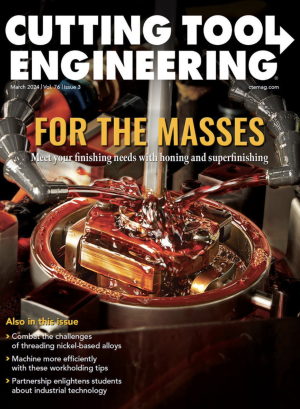Thanks to novel timesaving technology, a new addition to a metal additive manufacturing line can turn out parts twice as fast as other machines of its kind.
That’s the word from Renishaw Inc., West Dundee, Illinois, about the RenAM 500 Ultra, the latest in the company’s RenAM 500 series of laser powder bed fusion (LPBF) systems. Renishaw also touts the system’s ability to slash metal AM times without adversely impacting part quality.
Speeding up the LPBF process is Renishaw’s patented Tempus technology, which features new scanning algorithms that allow the system’s laser to fire into dispensed powder while the recoater, or wiper, is spreading the powder layer. Therefore, “you are eliminating a significant amount of delay waiting for the wiper to make a movement back and forth across the build plate,” noted John Laureto, Renishaw’s additive manufacturing business manager for the Americas.
According to Renishaw, Tempus can cut build times by up to 9 seconds per layer compared to those of other machines in the RenAM 500 line. Since LPBF builds often contain thousands of layers, the technology can shave 10 or more hours off part manufacturing times, allowing the Ultra to complete builds in half the time taken by other RenAM 500 systems in some cases, Laureto noted.

Also notable is the system’s advanced process-monitoring technology, which gives users detailed information about each build. For layer-by-layer assessments of build quality, white-light photographs of the build area are taken before and after each layer is created. In addition, Laureto pointed to the in situ process-monitoring modules that allow the system to capture data from the melt pool (the area of molten material created by the laser) using a series of photodiodes calibrated to certain wavelength frequencies.
“We get reflections off the melt pool, and that data coming in can help us identify trends and potentially any deviation associated with (the laser’s) weld track,” he explained. This helps the system maintain an acceptable level of repeatability during the entire production cycle.
Though different in some respects from other RenAM 500 machines, the new system offers all the line’s basic features. This includes key components that are also manufactured by Renishaw. “We’re not buying those components and assembling them,” Laureto said. “So we understand the ins and outs of the machines down to things like the PLC.”
And like the rest of the RenAM 500 family, the Ultra comes with either a single high-power laser (500S) or a quad laser arrangement (500Q). Though the four-laser version carries a heftier price tag than the single-laser option, it prints faster and therefore offers significantly higher productivity, Laureto noted.
In addition, the RenAM 500 Ultra features the same AM chamber design as other machines in the line. This chamber, where laser fusion takes place, measures 250 mm x 250 mm in x and y (the build plane) and 350 mm in z. Renishaw uses these particular dimensions “because we can control what we call a class-leading metallurgical process inside that chamber,” Laureto explained. He added that this chamber size “works quite well” for a number of medical applications, including hip, knee, spine, cranial and dental products.
In the aerospace and defense sectors, applications include engine, landing gear and fixturing components made of materials such as copper, aluminum and high-temperature alloys. “On the aerospace front, the high quality of the parts is a big selling point for us,” Laureto said. “We would argue that in our build-platform size, we have the highest-quality weld in the industry.”
Contact Details
Related Glossary Terms
- alloys
alloys
Substances having metallic properties and being composed of two or more chemical elements of which at least one is a metal.
- lapping compound( powder)
lapping compound( powder)
Light, abrasive material used for finishing a surface.
- wiper
wiper
Metal-removing edge on the face of a cutter that travels in a plane perpendicular to the axis. It is the edge that sweeps the machined surface. The flat should be as wide as the feed per revolution of the cutter. This allows any given insert to wipe the entire workpiece surface and impart a fine surface finish at a high feed rate.








